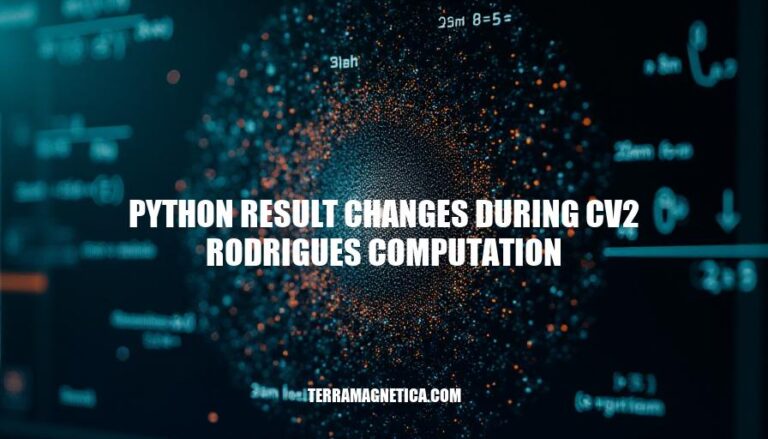


In computer vision and image processing, the cv2.Rodrigues function in Python’s OpenCV library is crucial for converting rotation vectors to rotation matrices and vice versa. However, users often encounter unexpected result changes during these computations. Understanding these changes is essential for ensuring accurate 3D transformations and maintaining the integrity of image processing tasks, which are foundational for applications like object detection, augmented reality, and robotics.
The cv2.Rodrigues function in OpenCV is a powerful tool for converting between rotation matrices and rotation vectors. Here’s a detailed explanation of its purpose and usage:
The cv2.Rodrigues function is used to convert a rotation matrix to a rotation vector and vice versa. This conversion is essential in various computer vision tasks, such as camera pose estimation, 3D reconstruction, and robotics. The function is based on Rodrigues’ rotation formula, which is a mathematical technique for rotating a vector in 3D space.
import cv2
output, jacobian = cv2.Rodrigues(input)
To convert a rotation vector to a rotation matrix, pass the rotation vector as input to the cv2.Rodrigues function:
import numpy as np
import cv2
rvec = np.array([0.1, 0.2, 0.3], dtype=np.float32)
R, _ = cv2.Rodrigues(rvec)
print("Rotation matrix:")
print(R)
The output R will be a 3×3 rotation matrix representing the same rotation as the input rotation vector.
Conversely, to convert a rotation matrix to a rotation vector, pass the rotation matrix as input to the cv2.Rodrigues function:
import numpy as np
import cv2
R = np.array([
[0.93629336, -0.27509585, 0.21835066],
[0.28962948, 0.95642509, -0.03695701],
[-0.19866933, 0.0978434, 0.97517033]
], dtype=np.float32)
rvec, _ = cv2.Rodrigues(R)
print("Rotation vector:")
print(rvec)
The output rvec will be a 3×1 rotation vector representing the same rotation as the input rotation matrix.
The cv2.Rodrigues function is widely used in:
This function is a fundamental tool in computer vision and robotics, enabling seamless conversion between rotation representations.
When working with cv2.Rodrigues in Python, several common issues and challenges can arise:
Numerical Instability: This can occur due to the inherent limitations of floating-point arithmetic. Small errors in the input rotation matrix can lead to significant deviations in the output rotation vector and vice versa.
Precision Errors: Precision issues often stem from the limited precision of floating-point numbers. This can cause inaccuracies when converting between rotation matrices and rotation vectors.
Reflection Issues: If the determinant of the rotation matrix is -1, it indicates a reflection rather than a pure rotation. This can lead to incorrect results when using cv2.Rodrigues.
Degenerate Configurations: Certain configurations of the input data can lead to degenerate cases where the algorithm fails to produce accurate results.
Algorithm Limitations: The implemented algorithm in OpenCV might have limitations that affect the accuracy of the results, especially in edge cases or with specific types of input data.
These challenges highlight the importance of careful input validation and understanding the limitations of the algorithms used.
Several factors can lead to variations in results during the cv2.Rodrigues computation in Python:
Input Data Variations:
Algorithmic Differences:
Computational Limitations:
These factors combined can lead to the observed changes in results during the cv2.Rodrigues computation.
Here are some strategies and best practices to mitigate result changes during cv2.Rodrigues computation in Python:
Data Normalization:
cv2.normalize() to standardize the input data.Higher Precision Data Types:
np.float64 instead of np.float32 for higher precision.Algorithmic Adjustments:
These practices can help achieve more stable and reliable results during cv2.Rodrigues computations.
Here are some case studies and examples where Python result changes during cv2.Rodrigues computation have been observed:
Case Study: Inconsistent Rotation Vector to Rotation Matrix Conversion
cv2.Rodrigues to convert rotation vectors to rotation matrices.cv2.Rodrigues, which stabilized the results.Example: Discrepancies in Rotation Matrix Computation
cv2.Rodrigues to convert rotation matrices back to rotation vectors for a robotics application.Case Study: Variability in 3D Reconstruction
cv2.Rodrigues to handle the rotation transformations between the stereo camera frames.cv2.Rodrigues. This approach minimized the variability and improved the accuracy of the 3D reconstruction.These examples highlight the importance of handling numerical stability and precision when using cv2.Rodrigues in Python.
The article discusses how Python’s OpenCV library, specifically the cv2.Rodrigues function, can produce varying results due to several factors such as numerical instability, floating-point precision errors, and hardware differences. These changes in results can have significant implications for computer vision applications that rely on accurate rotation transformations.
To mitigate these issues, the article suggests several strategies and best practices, including data normalization, using higher precision data types, and algorithmic adjustments. By implementing these techniques, developers can achieve more stable and reliable results during cv2.Rodrigues computations.
The article also presents case studies and examples where Python result changes during cv2.Rodrigues computation have been observed in real-world applications, such as 3D pose estimation, robotics, and stereo vision. These examples highlight the importance of understanding and addressing numerical stability and precision when using cv2.Rodrigues in practical applications.
In conclusion, it is essential to be aware of these changes in results and take steps to address them, as they can have significant consequences for the accuracy and reliability of computer vision applications. By following the suggested strategies and best practices, developers can ensure that their applications produce consistent and accurate results, even when using cv2.Rodrigues.